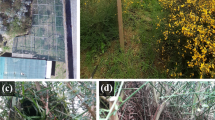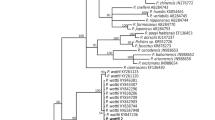Summary
InRopalidia plebeiana, combs made in the previous year are often reused by foundresses in the following spring and structurally divided into subnests by them. Close observations of the comb dividing process revealed that: 1) combs that had multiple “brood areas” (areas where cells had eggs) were frequently divided into subnests, while those with single brood areas were never divided; 2) groups of foundresses each occupied a particular brood area even before comb division started; and 3) frequency with which a foundress practiced comb cutting was independent of her social status or oviposition frequency. These observations suggest that the initial grouping of foundresses that colonize an old nest leads to subsequent comb division, rather than the major egg layers cutting combs to safeguard their oviposition territories from their rivals.
Similar content being viewed by others
References
Bornais, K. M., C. M. Larch, G. J. Gamboa and R. B. Daily, 1983. Nestmate discrimination among laboratory overwintered foundresses of the paper waspPolistes fuscatus.Can. Entomol. 115:655–658.
Itô, Y. and S. Higashi, 1987. Spring behaviour ofRopalidia plebeiana (Hymenoptera: Vespidae) within a huge aggregation on nests.Appl. Ent. Zool. 22:519–527.
Itô, Y., O. Iwahashi, S. Yamane and Sk. Yamane, 1985. Overwintering and nest reutilization inRopalidia fasciata.Kontyû 53:486–490.
Itô, Y., S. Yamane and J. P. Spradbery, 1988. Population consequences of huge nesting aggregations ofRopalidia plebeiana (Hymenoptera: Vespidae).Res. Popul. Ecol. 50:279–295.
Jeanne, R. L., 1972. Social biology of the Neotropical waspMischocyttarus drewseni.Bull. Mus. Comp. Zool. Harvard Univ. 144:63–150.
Jeanne, R. L., 1982. Recognition of former nestmates during colony founding by the social waspPolistes fuscatus (Hymenopera: Vespidae).Behav. Ecol. Sociobiol. 11:283–285.
Klahn, J. E., 1979. Philopatric and nonphilopatric foundress associations in the social waspPolistes fuscatus.Behav. Ecol. Sociobiol. 5:417–424.
Litte, M., 1977. Behavioral ecology of the social wasp,Mischocyttarus mexicanus.Behav. Ecol. Sociobiol. 2:229–246.
Michener, C. D. and B. H. Smith, 1987. Kin recognition in primitively eusocial insects. In: D. J. C. Fletcher and C. D. Michener (eds.)Kin Recognition in Animals. John Wiley & Sons, New York, pp. 209–242.
Richards, O. W., 1978. The Australian social wasps (Hymenoptera: Vespidae).Aust. J. Zool., Suppl. Ser. No. 61:1–132.
Strassmann, J. E., 1979. Honey caches help female paper wasps (Polistes annularis) survive Texas winters.Science 204:207–209.
West-Eberhard, M. J., 1969. The biology of polistine wasps.Misc. Publ. Mus. Zool. Univ. Michigan 140:1–101.
Yamane, S., Y. Itô and J. P. Spradbery, 1991. Comb cutting inRopalidia plebeiana: a new process of colony fission in social wasps (Hymenoptera: Vespidae).Ins. soc. 38:105–110.
Author information
Authors and Affiliations
Rights and permissions
About this article
Cite this article
Makino, S., Yamane, S., Itô, Y. et al. Process of comb division of reused nests in the Australian paper waspRopalidia plebeiana (Hymenoptera, Vespidae). Ins. Soc 41, 411–422 (1994). https://doi.org/10.1007/BF01240644
Received:
Revised:
Accepted:
Issue Date:
DOI: https://doi.org/10.1007/BF01240644




